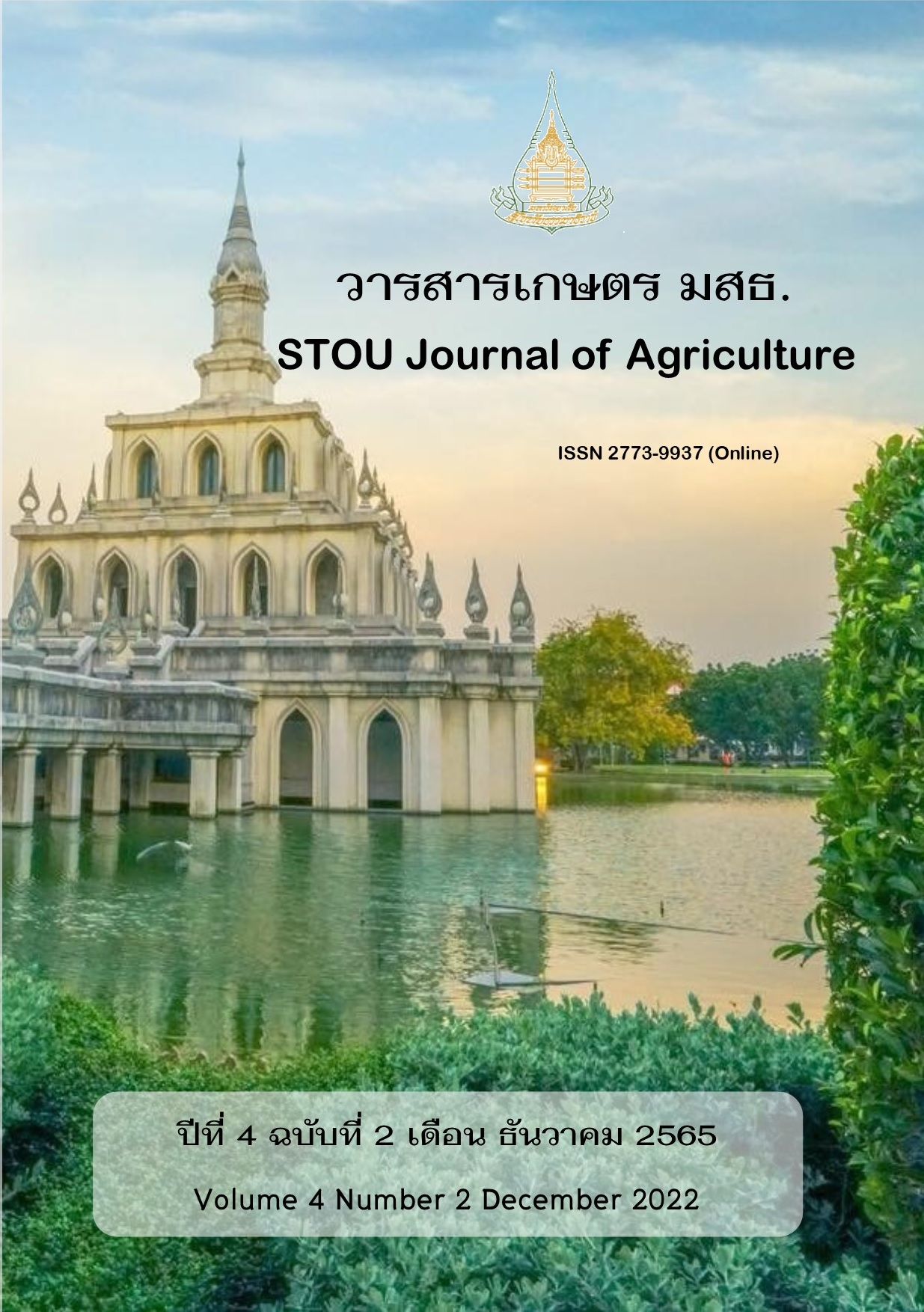Lyle’s Flying Fox (Pteropus lylei K. Andersen, 1908) of Thailand
Main Article Content
Abstract
The population of Lyle's flying fox (Pteropus lylei K. Andersen, 1908) in Thailand was estimated to be approximately 75,016 in 2017 from 30 roosting sites distributed across 17 provinces in central, eastern, and western Thailand. The roosting sites are mostly located in the vicinity of temples, flat areas, and near permanent water sources. The Lyle's flying fox spends the day resting and goes out to forage at night. The foraging distance ranges from 2.2-23.64 km. On average, it eats 217.5 grams of food daily, primarily fruits, with 34 species reported. The gestation period is 4-5 months, and the mother carries the infant on her belly at all times for the first two weeks after giving birth. The infant starts to fly at about two months old and reaches sexual maturity at one year old. Male is bigger than the female with the head-and-body length between 185 – 200 mm, ear length between 30 – 50.5 mm, forearm length between 130 – 170 mm, hindfeet length between 21 – 49 mm, and weight between 204 – 685 g. Currently, there is 38,904 sq.km. of suitable area for roosting sites in Thailand; however, the suitable area tends to increase in the northern central and northeastern regions. Furthermore, there are several reports on the hunting and destruction of forests at roosting sites in Thailand.
Article Details

This work is licensed under a Creative Commons Attribution-NonCommercial-NoDerivatives 4.0 International License.
บทความที่ได้รับการตีพิมพ์เป็นลิขสิทธฺ์ของวารสารเกษตร มสธ.
ข้อความที่ปรากฎใน
References
กัลยาณี บุญเกิด และไสว วังหงษา. (2546). ประชากรและการกระจายของค้างคาวแม่ไก่ (Pteropus lylei) ในที่ราบภาคกลาง, น. 91 - 100. ใน ผลงานวิจัยและรายงานความก้าวหน้างานวิจัยประจำปี 2546 (ฉบับที่1). ฝ่ายการพิมพ์ ส่วนผลิตสื่อ สำนักงานสารสนเทศ, กรมอุทยานแห่งชาติ สัตว์ป่า และพันธุ์พืช, กรุงเทพฯ.
จีรพัฒน์ บุญเนือง. (2520). ชีววิทยาบางประการของค้างคาวแม่ไก่ภาคกลาง. (วิทยานิพนธ์ปริญญาวิทยาศาสตรมหาบัณฑิต) มหาวิทยาลัยเกษตรศาสตร์, กรุงเทพฯ.
พิพัฒน์ สร้อยสุข. (2554). บัญชีรายชื่อค้างคาวในประเทศไทย. วารสารสัตว์ป่าเมืองไทย, 18 (1): 121-151.
ประทีป ด้วงแค. (2550). ค้างคาวเมืองไทย: สำหรับการจำแนกชนิดในภาคสนาม. พิมพ์ครั้งที่ 1 โรงพิมพ์และทำปกเจริญผล: นนทบุรี.
ประทีป ด้วงแค. (2554). บัญชีรายชื่อสัตว์ป่าเลี้ยงลูกด้วยนมในประเทศไทย. วารสารสัตว์ป่าเมืองไทย, 18(1): 82-120.
ประทีป ด้วงแค สุภาภรณ์ วัชรพฤษาดี วชิรพล คำบูชา พงษ์สิทธิ์ ศรีคุณเมือง พัชรกิติ เพ็งสกุล อิงอร ไชยเยศ นันทชัย พงศ์พัฒนานุรักษ์ และธีระวัฒน์ เหมะจุฑา. (2558). การติดตามแหล่งเกาะนอนและประชากรของค้างคาวแม่ไก่ภาคกลาง (Pteropus lylei) ในประเทศไทย. คณะวนศาสตร์ มหาวิทยาลัยเกษตรศาสตร์, กรุงเทพฯ.
Brunet-Rossinni, A. K. and Austad, S. N. (2004). Ageing studies on bats: a review. Biogerontology, 5: 211-222.
Chaiyes, A.; Ariyaraphong, N.; Sukgosa, N.; Jangtarwan, K.; Ahmad, S.F.; Laopichienpong, N.; Singchat, W.; Panthum, T.; Duangjai, S.; Muangmai, N.; Wacharapluesadee, S.; Duengkae, P.; Srikulnath, K. (2022A). Evidence of Genetic Connectivity among Lyle’s Flying Fox Populations in Thailand for Wildlife Management and One Health Framework. Sustainability, 14: 10791. https://doi.org/10.3390/su141710791
Chaiyes, A., Duengkae, P., Suksavate, W., Pongpattananurak, N., Wacharapluesadee, S., Olival, K.J., Srikulnath, K., Pattanakiat, S., Hemachudha, T. (2022B). Mapping Risk of Nipah Virus Transmission from Bats to Humans in Thailand. Ecohealth, (19) doi: 10.1007/s10393-022-01588-6.
Chaiyes, A., Duengkae, P., Wacharapluesadee, S., Pongpattananurak, N., Olival, K.J. and Hemachudha, T. (2017). Assessing the distribution, roosting site characteristics, and population of Pteropus lylei in Thailand. Raffles Bulletin of Zoology, 65: 670–680.
Chaiyes, A., Escobar, L.E., Willcox, E.V., Duengkae, P., Suksavate, W., Watcharaanantapong, P., Pongpattananurak, P., Wacharapluesadee, S. and Hemachudha, T. (2020A). Population Abundances in the Context of the Niche Centroid Hypothesis: In Case of Pteropus lylei (Chiroptera). Bulletin of the Ecological Society of America, 101(3):e01719. https://doi.org/10.1002/bes2.1719
Chaiyes, A., Escobar, L.E., Willcox, E.V., Duengkae, P., Suksavate, W., Watcharaanantapong, P., Pongpattananurak P., Wacharapluesadee, S., Hemachudha, T. (2020B). An assessment of the niche centroid hypothesis: Pteropus lylei (Chiroptera). Ecosphere, DOI:10.1002/ecs2.3134
CITES. (2022). Appendices I, II and III. Available Source: www.cites.org., 12 December 2022.
Francis, C. M. (2008). A field guide to the mammals of Thailand and South-East Asia. Asia Books Co., Bangkok.
Hengjan, Y. (2011). Seasonal variation in emergence and activity pattern at roosting site of Lyle’s flying fox Pteropus lylei Andersen, 1908 at Wat Pho, Chachoengsao province. A Thesis Submitted in Partial Fulfillment of the Requirements for the Degree of Master of Science Program in Zoology. Faculty of Science Chulalongkorn University.
Hengjan, Y., Sae-Koo, N., Phichitrasilp, T., Ohmori, Y., Fujinami, H., and Hondo, E. (2018). Seasonal variation in the number of deaths in Pteropus lylei at Wat Pho Bang Khla temple, Thailand. The Journal of Veterinary Medical Science, 80(8):1364-1367.
Hondo, E., Inoue, N. Maeda, K. Rerkamnuaychoke W. and Duengkae P. (2010). Movement of Lyle's flying fox (Pteropus lylei) in Central Thailand. Journal of Wildlife in Thailand, 17: 55–63.
IUCN. (2022). Pteropus Lylei. IUCN Red List of Threatened Species. Retrieved December 12, 2022, from www.iucnredlist.org
Lekagul, B., and McNeely, J. A. (1988). Mammals of Thailand (2nded.). Bangkok: Sahakarn Bhaet. 758 pp.
Ravon, S., Furey, N.M., Hul, V., Cappelle, J. (2014). A rapid assessment of flying fox (Pteropus spp.) colonies in Cambodia. Cambodian Journal of Natural History, 1:14–18.
Simmons, N. B. (2005). Order Chiroptera. Pp. 312–529. In Mammal species of the World: a taxonomic and geographic reference (D. E. Wilson & D. M. Reeder, eds.). The Johns Hopkins University Press, Baltimore.
Simmons, N.B., Cirranello, A.L. (2020). Bat species of the world: a taxonomic and geographic database. Retrieved May 7, 2020, from https://www.batnames.org/.
Son, N.T., Thong, V.D., Tien, P.D. and Khoi, N.V. (2009). Status of flying fox Bat (Pteropus spp.) in Vietnam. Academia Journal of Biology, 31(3): 52-57.
Sukgosa, N., Duangjai, S., Duengkae, P., Wacharapluesadee, S., Songmongkol, P., Yingsakmongkon, S., Olival, K.J., Hemachudha, T. (2018). Genetic diversity and relationships among Lyle's flying fox colonies in Thailand. Agriculture and Natural Resources, 2: 607–611.
Waldien, D.L. & Tsang, S.M. (2021). Pteropus lylei. The IUCN Red List of Threatened Species 2021: e.T18734A22082429. Retrieved December 12, 2022, from https://dx.doi.org/10.2305/IUCN.UK.2021-1.RLTS.T18734A22082429.en
Weber, N., Duengkae, P., Fahr, J., Dechmann, D., Phengsakul, P., Khumbucha, W., Newman, S., Siriaroonrat, B., Wacharaplusesadee, S., Maneeornand, P., Wikelski, M. (2015). High resolution GPS tracking of Lyle’s Flying Fox between temple orchards in central Thailand. The Journal of Wildlife Management, 79(6): 957 – 968.

